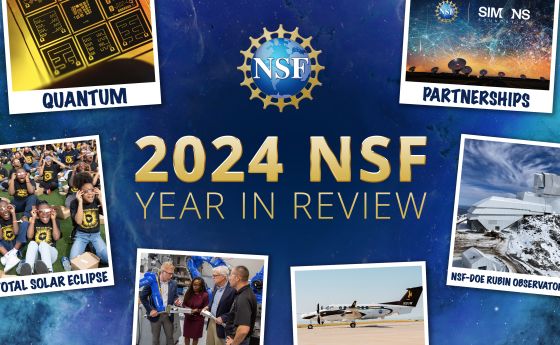
NSF supports efforts to emphasize the ability in 'disability'
From telework and dictation software to screen readers and protective gear for service dogs, there are more ways for people with disabilities to thrive in the STEM workforce than ever before.
However, according to the U.S. National Science Foundation National Center for Science and Engineering Statistics, while one out of every five people with disabilities are employed in science, technology, engineering and math occupations, they still only represent 3% of the total STEM workforce. Considering most Americans will experience a disability at some point during their lives, research that increases accessibility is vital.
For decades, NSF has invested in research to support and aid people with disabilities. Over the last five years alone, the agency has invested nearly $100 million to help make STEM more accessible, inclusive and inviting across three key areas: 1) developing positive, inclusive STEM identities; 2) making STEM education and research more accessible; and 3) developing assistive technologies for the STEM workplace.
Below are examples of some of the major achievements made possible through the dedication and hard work of NSF-supported researchers and their teams.
Envisioning oneself in STEM
When it comes to getting people involved in STEM, one of the major barriers is the ability to see oneself in STEM. Many children today still see STEM as something for white, able-bodied boys and will dismiss the idea of themselves in STEM accordingly. NSF has been supporting research to understand and break these barriers. Researchers at the University of Rochester identified ways science centers and museums could improve their methods to connect with people with learning disabilities. And investigators at the Museum of Science in Boston found ways science exhibits could develop designs that incorporated intersectional identities (the ways in which different aspects of one's identity, such as gender and disability status, intersect to create a new identity). Reshaping how museums craft exhibits is essential to helping visitors have positive, inclusive experiences.
In March 2024, the Smithsonian Institution's Lemelson Center for the Study of Invention and Innovation unveiled its latest exhibit, Change Your Game/Cambia tu juego. The 3,500-square-foot interactive space allows children and adults to explore how STEM and sports intersect, encouraging visitors to see themselves as “game changers” who can shape the world through inventive problem solving. The exhibit showcases how engineers with disabilities made sports more accessible for people with disabilities and was made possible, in part, through a $1.8 million grant from NSF. By placing inventors with disabilities at the forefront of the exhibit, visitors with disabilities see themselves as inventors, which is imperative to cultivating a STEM identity.
Accessible ways to learn about and share STEM knowledge
Educational video games are a study tool that can greatly benefit children, especially children with learning disabilities, by providing an engaging alternative to practice skills gained in the classroom. A nearly $1.4 million NSF grant is helping researchers at North Carolina State University and the University of Central Florida develop a new game, Dream 2B, designed to help students with learning disabilities grasp the mathematical concepts that are the foundation for many STEM careers. While the project is still being developed, preliminary results show that the game has promise for improving students' understanding of fractions.
Conferences are a popular way for researchers, innovators and other people in STEM to share their research, unveil new inventions and expand their networks. Gallaudet University in Washington, D.C., hosted the Mathematical Cognition and Learning Society conference, the first with accessibility at the forefront. American Sign Language and deafblind interpreters, low-stimulation rooms and live captioning were just a few of the accessibility changes the NSF-funded conference made to ensure it was accessible to all attendees. When asked about the conference, Josefine Andin of Linköping University in Sweden, who uses a wheelchair, told Gallaudet University, "People don't come talk to me at conferences. They don't see me as a researcher. It's so different here." Accessibility changes made it possible for all the researchers to actively participate and learn from each other without feeling left out or overlooked.
Technology for navigating a new path forward
People with disabilities are more likely to be unemployed than their able-bodied peers. Technologies that remove barriers outside of a person's control are vital to increasing the employment rates of people with disabilities. NSF awarded a combined nearly $2.8 million in funding to increase employment opportunities for people with upper-limb disabilities through the development of a wearable robotic exoskeleton. It was made possible through a joint project between researchers at New York University, City University of New York, Rutgers University and North Carolina State University. While it is ongoing, a recent breakthrough may offer an effective and efficient way to rapidly develop assistive robots for both individuals with and without disabilities. In addition, two of the researchers went on to write an article for the Harvard Business Review advising ways to improve the hiring process for candidates with disabilities. The project has resulted in several more scientific papers presented at conferences, including the Rutgers University Disability Awareness Month symposium, and developed a 3D-printed exoskeleton education kit that will eventually be made available for free for other educators to use.






